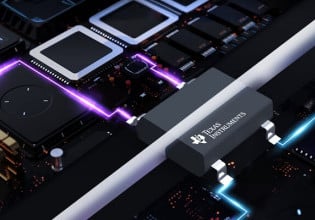Renesas Introduces Critical-Conduction-Mode PFC Control IC
Renesas Technology America, Inc. announced the R2A20112 critical-mode power factor correction (PFC) control IC for ac-dc power supplies, which the company claims is the first device of its type to implement interleaved operation. The new device enables the design of small, thin, low-noise, high-efficiency ac-dc power supplies that are essential for flat-panel TVs, game machines, PCs, copiers, and many other consumer and office automation products.
In years past, ac-dc power supplies typically used simple choke input rectification or similar voltage conversion techniques that suffer power losses due to waveform mismatches and timing variations between the voltage and current waveforms. More recently, regulations have come into effect mandating that various kinds of devices incorporate a PFC controller, such as Renesas' previously released HA16174 and R2A20111 intelligent-type continuous-current-conduction-mode PFC control ICs. While these ICs suffice for many applications, today's digital home appliances such as flat-panel TVs require smaller, slim and quiet power supplies with higher efficiency. Thus, there is a need for a PFC control solution that can shrink the size of the power supply and reduce the amount of heat dissipated to a level low enough to eliminate the requirement for a noisy cooling fan.
The R2A20112 critical-conduction-mode PFC control IC meets these power supply design needs in three ways. First, it uses two signals (master and slave) for control, allowing critical mode PFC control with interleaved operation that reduces variations in operating timing. The slave control circuit allows highly precise current distribution, making it possible to reduce the size of components such as the input filter, step-up coil, and input/output capacitors.
Second, the device uses various techniques that enable system simplification. For example, a ZCS (zero-current switching) function causes the power MOSFET to switch at the exact instant at which no current is flowing. This reduces the device's heat emission and allows a smaller, less complex heat sink. Also, the combination of ZCS and interleaved operation prevents the flow of redundant currents such as step-up-diode recovery current. It also controls the flow of appropriate currents and reduces the power supply line noise and ripple current. These benefits combine to decrease the peak level of radiation noise in the power supply, allowing simplifications of the noise shielding and ac input filter.
Third, the power conversion efficiency of the R2A20112 IC is better by 5% or more compared with Renesas' previous products, due to reductions in switching loss, recovery loss, and conduction loss. As a result, heat sinks can be even smaller and the overall dissipation of the power supply can be reduced enough to make a cooling fan unnecessary.
The R2A20112SP is priced at $1.00 in packages of SOP-16, and the R2A20112DD at $1.00 in packages of DILP-16. Both are scheduled to be available in the first quarter of 2007.






